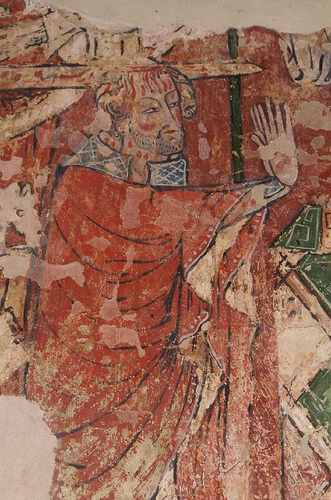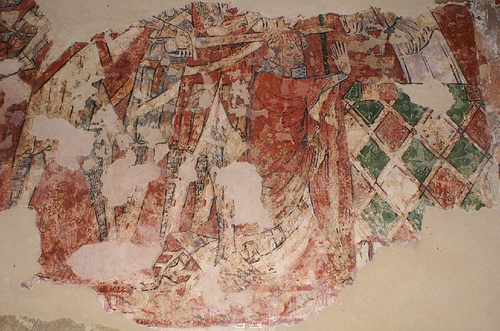Medieval History

We are back again in the north aisle at South Newington in Oxfordshire, a bit further west of the glorious image of the Virgin and Child we saw in an earlier post. This time we have a panel depicting the martyrdom of Archbishop Thomas Becket, who was killed in Canterbury Cathedral in 1170. As St Thomas of Canterbury, he was perhaps the most revered saint of medieval England. We are at the moment of martyrdom, where one of the knights has plunged his sword in the archbishop's head. At the far side of the altar with its gorgeous multi-coloured frontal, stands Edward Grim, one of Becket's chaplains. Grim, who was injured by one of the knghts who killed Becket, wrote an account of the scene. I include the rather bloody bit that refers to the last moments of the saint:
"He had barely finished speaking when the impious knight, fearing that [Thomas] would be saved by the people and escape alive, suddenly set upon him and, shaving off the summit of his crown which the sacred chrism consecrated to God, he wounded the sacrificial lamb of God in the head; the lower arm of the writer was cut by the same blow. Indeed [the writer] stood firmly with the holy archbishop, holding him in his arms - while all the clerics and monks fled - until the one he had raised in opposition to the blow was severed. Behold the simplicity of the dove, behold the wisdom of the serpent in this martyr who presented his body to the killers so that he might keep his head, in other words his soul and the church, safe; nor would he devise a trick or a snare against the slayers of the flesh so that he might preserve himself because it was better that he be free from this nature! O worthy shepherd who so boldly set himself against the attacks of wolves so that the sheep might not be torn to pieces! and because he abandoned the world, the world - wanting to overpower him - unknowingly elevated him. Then, with another blow received on the head, he remained firm. But with the third the stricken martyr bent his knees and elbows, offering himself as a living sacrifice, saying in a low voice, "For the name of Jesus and the protection of the church I am ready to embrace death." But the third knight inflicted a grave wound on the fallen one; with this blow he shattered the sword on the stone and his crown, which was large, separated from his head so that the blood turned white from the brain yet no less did the brain turn red from the blood; it purpled the appearance of the church with the colors of the lily and the rose, the colors of the Virgin and Mother and the life and death of the confessor and martyr. The fourth knight drove away those who were gathering so that the others could finish the murder more freely and boldly. The fifth - not a knight but a cleric who entered with the knights - so that a fifth blow might not be spared him who had imitated Christ in other things, placed his foot on the neck of the holy priest and precious martyr and (it is horrible to say) scattered the brains with the blood across the floor, exclaiming to the rest, "We can leave this place, knights, he will not get up again." Web source http://www.fordham.edu/halsall/source/grim-becket.html

- The Fake Medieval Images In Canterbury Cathedral
Thousands of visitors come into Canterbury Cathedral each day, where they gaze upon the hundreds of years of history in one of England?s greatest churches. Many of them will see the great stained glass images in the windows of the cathedral, believing...
- Thomas Becket By John Guy: Review
Few figures in medieval history are as famous as Thomas Becket, and fewer have been subject to such utterly differing interpretations. To pious Englishmen up to the Reformation, he was a miracle-working saint, whose blood (widely available in diluted...
- William Monahan Tackling Becket
He has Colin Farrell/Keira Knightley/Colin Farrell gangster romance London Boulevard about to hit cinemas, but writer William Monahan has already targeted his next directing job. He?s planning to adapt and shoot a fresh take on Jean Anouilh?s play Becket....
- Call For Papers: St. Thomas Becket And The Vernacular Medieval Literature
Monte Verità in Switzerland will host the International Medieval Conference next year. The conference is taking place from October 17-22 on the theme 'St. Thomas Becket and the Vernacular Medieval Literature'. In their call for papers, the programme...
- Henry Ii, Ivory Liturgical Comb
A liturgical comb, c. 1200, English perhaps Canterbury. Ivory, Metropolitan Museum of Art. Carving shows Henry II giving Thomas Becket the archbishopric of Canterbury. The event occurred in Falaise, Normandy, May 1162. On the right it shows the boat ready...
Medieval History
Death of St Thomas of Canterbury - another wallpainting

We are back again in the north aisle at South Newington in Oxfordshire, a bit further west of the glorious image of the Virgin and Child we saw in an earlier post. This time we have a panel depicting the martyrdom of Archbishop Thomas Becket, who was killed in Canterbury Cathedral in 1170. As St Thomas of Canterbury, he was perhaps the most revered saint of medieval England. We are at the moment of martyrdom, where one of the knights has plunged his sword in the archbishop's head. At the far side of the altar with its gorgeous multi-coloured frontal, stands Edward Grim, one of Becket's chaplains. Grim, who was injured by one of the knghts who killed Becket, wrote an account of the scene. I include the rather bloody bit that refers to the last moments of the saint:
"He had barely finished speaking when the impious knight, fearing that [Thomas] would be saved by the people and escape alive, suddenly set upon him and, shaving off the summit of his crown which the sacred chrism consecrated to God, he wounded the sacrificial lamb of God in the head; the lower arm of the writer was cut by the same blow. Indeed [the writer] stood firmly with the holy archbishop, holding him in his arms - while all the clerics and monks fled - until the one he had raised in opposition to the blow was severed. Behold the simplicity of the dove, behold the wisdom of the serpent in this martyr who presented his body to the killers so that he might keep his head, in other words his soul and the church, safe; nor would he devise a trick or a snare against the slayers of the flesh so that he might preserve himself because it was better that he be free from this nature! O worthy shepherd who so boldly set himself against the attacks of wolves so that the sheep might not be torn to pieces! and because he abandoned the world, the world - wanting to overpower him - unknowingly elevated him. Then, with another blow received on the head, he remained firm. But with the third the stricken martyr bent his knees and elbows, offering himself as a living sacrifice, saying in a low voice, "For the name of Jesus and the protection of the church I am ready to embrace death." But the third knight inflicted a grave wound on the fallen one; with this blow he shattered the sword on the stone and his crown, which was large, separated from his head so that the blood turned white from the brain yet no less did the brain turn red from the blood; it purpled the appearance of the church with the colors of the lily and the rose, the colors of the Virgin and Mother and the life and death of the confessor and martyr. The fourth knight drove away those who were gathering so that the others could finish the murder more freely and boldly. The fifth - not a knight but a cleric who entered with the knights - so that a fifth blow might not be spared him who had imitated Christ in other things, placed his foot on the neck of the holy priest and precious martyr and (it is horrible to say) scattered the brains with the blood across the floor, exclaiming to the rest, "We can leave this place, knights, he will not get up again." Web source http://www.fordham.edu/halsall/source/grim-becket.html

- The Fake Medieval Images In Canterbury Cathedral
Thousands of visitors come into Canterbury Cathedral each day, where they gaze upon the hundreds of years of history in one of England?s greatest churches. Many of them will see the great stained glass images in the windows of the cathedral, believing...
- Thomas Becket By John Guy: Review
Few figures in medieval history are as famous as Thomas Becket, and fewer have been subject to such utterly differing interpretations. To pious Englishmen up to the Reformation, he was a miracle-working saint, whose blood (widely available in diluted...
- William Monahan Tackling Becket
He has Colin Farrell/Keira Knightley/Colin Farrell gangster romance London Boulevard about to hit cinemas, but writer William Monahan has already targeted his next directing job. He?s planning to adapt and shoot a fresh take on Jean Anouilh?s play Becket....
- Call For Papers: St. Thomas Becket And The Vernacular Medieval Literature
Monte Verità in Switzerland will host the International Medieval Conference next year. The conference is taking place from October 17-22 on the theme 'St. Thomas Becket and the Vernacular Medieval Literature'. In their call for papers, the programme...
- Henry Ii, Ivory Liturgical Comb
A liturgical comb, c. 1200, English perhaps Canterbury. Ivory, Metropolitan Museum of Art. Carving shows Henry II giving Thomas Becket the archbishopric of Canterbury. The event occurred in Falaise, Normandy, May 1162. On the right it shows the boat ready...
